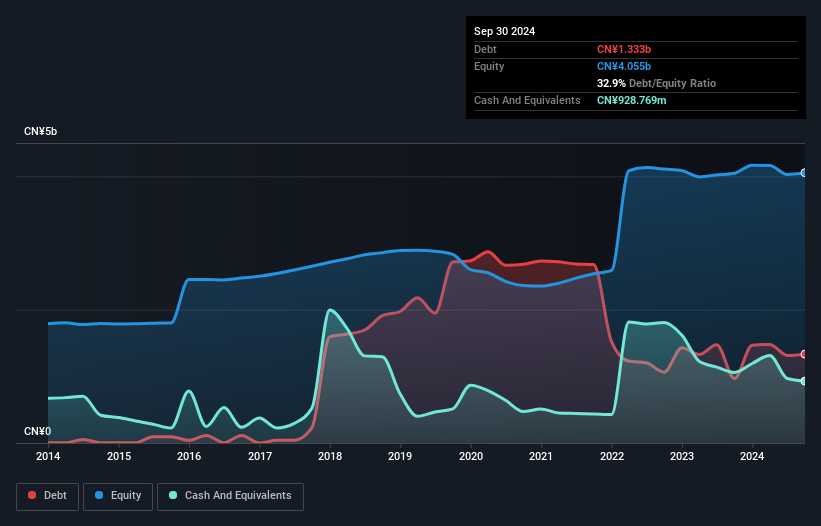The external fund manager backed by Berkshire Hathaway's Charlie Munger, Li Lu, makes no bones about it when he says 'The biggest investment risk is not the volatility of prices, but whether you will suffer a permanent loss of capital.' So it might be obvious that you need to consider debt, when you think about how risky any given stock is, because too much debt can sink a company. We note that Xiamen Changelight Co., Ltd. (SZSE:300102) does have debt on its balance sheet. But the real question is whether this debt is making the company risky.
When Is Debt Dangerous?
Generally speaking, debt only becomes a real problem when a company can't easily pay it off, either by raising capital or with its own cash flow. Part and parcel of capitalism is the process of 'creative destruction' where failed businesses are mercilessly liquidated by their bankers. However, a more usual (but still expensive) situation is where a company must dilute shareholders at a cheap share price simply to get debt under control. Of course, plenty of companies use debt to fund growth, without any negative consequences. When we examine debt levels, we first consider both cash and debt levels, together.
What Is Xiamen Changelight's Net Debt?
You can click the graphic below for the historical numbers, but it shows that as of September 2024 Xiamen Changelight had CN¥1.33b of debt, an increase on CN¥967.0m, over one year. However, because it has a cash reserve of CN¥928.8m, its net debt is less, at about CN¥404.2m.

How Strong Is Xiamen Changelight's Balance Sheet?
 According to the last reported balance sheet, Xiamen Changelight had liabilities of CN¥1.55b due within 12 months, and liabilities of CN¥839.2m due beyond 12 months. Offsetting these obligations, it had cash of CN¥928.8m as well as receivables valued at CN¥1.22b due within 12 months. So it has liabilities totalling CN¥245.6m more than its cash and near-term receivables, combined.
According to the last reported balance sheet, Xiamen Changelight had liabilities of CN¥1.55b due within 12 months, and liabilities of CN¥839.2m due beyond 12 months. Offsetting these obligations, it had cash of CN¥928.8m as well as receivables valued at CN¥1.22b due within 12 months. So it has liabilities totalling CN¥245.6m more than its cash and near-term receivables, combined.
Of course, Xiamen Changelight has a market capitalization of CN¥11.4b, so these liabilities are probably manageable. Having said that, it's clear that we should continue to monitor its balance sheet, lest it change for the worse.
We use two main ratios to inform us about debt levels relative to earnings. The first is net debt divided by earnings before interest, tax, depreciation, and amortization (EBITDA), while the second is how many times its earnings before interest and tax (EBIT) covers its interest expense (or its interest cover, for short). The advantage of this approach is that we take into account both the absolute quantum of debt (with net debt to EBITDA) and the actual interest expenses associated with that debt (with its interest cover ratio).
Xiamen Changelight has a very low debt to EBITDA ratio of 0.93 so it is strange to see weak interest coverage, with last year's EBIT being only 1.7 times the interest expense. So while we're not necessarily alarmed we think that its debt is far from trivial. We also note that Xiamen Changelight improved its EBIT from a last year's loss to a positive CN¥57m. When analysing debt levels, the balance sheet is the obvious place to start. But you can't view debt in total isolation; since Xiamen Changelight will need earnings to service that debt. So if you're keen to discover more about its earnings, it might be worth checking out this graph of its long term earnings trend.
Finally, a business needs free cash flow to pay off debt; accounting profits just don't cut it. So it is important to check how much of its earnings before interest and tax (EBIT) converts to actual free cash flow. During the last year, Xiamen Changelight burned a lot of cash. While that may be a result of expenditure for growth, it does make the debt far more risky.
Our View
While Xiamen Changelight's interest cover makes us cautious about it, its track record of converting EBIT to free cash flow is no better. But its not so bad at managing its debt, based on its EBITDA,. Taking the abovementioned factors together we do think Xiamen Changelight's debt poses some risks to the business. So while that leverage does boost returns on equity, we wouldn't really want to see it increase from here. When analysing debt levels, the balance sheet is the obvious place to start. But ultimately, every company can contain risks that exist outside of the balance sheet. For example, we've discovered 2 warning signs for Xiamen Changelight (1 doesn't sit too well with us!) that you should be aware of before investing here.
When all is said and done, sometimes its easier to focus on companies that don't even need debt. Readers can access a list of growth stocks with zero net debt 100% free, right now.
Have feedback on this article? Concerned about the content? Get in touch with us directly. Alternatively, email editorial-team (at) simplywallst.com.
This article by Simply Wall St is general in nature. We provide commentary based on historical data and analyst forecasts only using an unbiased methodology and our articles are not intended to be financial advice. It does not constitute a recommendation to buy or sell any stock, and does not take account of your objectives, or your financial situation. We aim to bring you long-term focused analysis driven by fundamental data. Note that our analysis may not factor in the latest price-sensitive company announcements or qualitative material. Simply Wall St has no position in any stocks mentioned.

